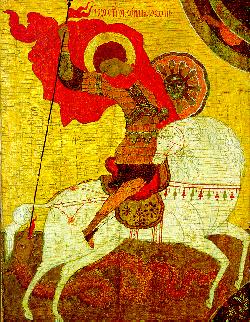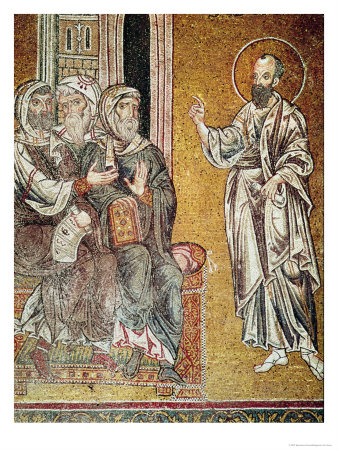|
|||
|---|---|---|---|
| This weekly bulletin insert complements the curriculum published by the Department of Christian Education of the Orthodox Church in America. This and many other Christian Education resources are available at http://dce.oca.org. | |||

The Great Martyr and Wonderworker George was born to Christian parents in Cappadocia, toward the end of the third century. George always knew he wanted to be a soldier, and quickly rose in the Roman army ranks, gaining the status of tribune. He enjoyed the favor of the Emperor Diocletian, who had known his family, and was also an excellent soldier. But Diocletian hated Christianity and brutally punished anyone identified as a follower of Jesus Christ. When George saw the way Christians were persecuted and killed, he confronted the emperor, condemning the cruel acts and proclaiming his own Christian faith. He even renounced his army commission, an act which was seen as deeply insulting to Rome and her ruler. The emperor had George jailed and tortured. The young prisoner prayed constantly and was saved from death over and over again despite the terrible things done to him. The sight of these miracles and of George's faithful prayer led many who witnessed them to become Christians, including the emperor's wife Alexandra. This inflamed Diocletian's fury and frustration and in 303 he ordered his wife and George beheaded. The well-known image of Saint George shows him thrusting a long spear into a menacing beast, a dragon, but accounts of his life don't include such an episode. Yet it is an appropriate image, because it reflects his courage in challenging powerful evil and overcoming its might through prayer. The image reminds us that we also must stand up to evil and defend the faith. We also need to be people of prayer who can face "dragons" of various kinds rather than running away from them. Saint George continues to be venerated today. He is the patron saint of England; the city of Moscow has several statues and other depictions of him; countless Orthodox churches are named for him. People still look to him for miracles and healing, too. Among many shrines is a small, unimposing one at Beit Jala, near Bethlehem. Visitors, both Muslim and Christian, come in great numbers to pray, to ask for healing, and to honor this beloved "slayer of the dragon." 
Acts 9:1-19 tells of the apostle Paul's conversion on the road to Damascus. The first words, describing Paul, make him sound like a man possessed by a "dragon" himself. We read: "Meanwhile Saul, still breathing threats and murder against the disciples of the Lord..." Saul so hates Christians that he wants to round up any there are in Damascus, bind them, and bring them to Jerusalem to face the Temple authorities. Paul has an inner dragon to face and conquer. He must change his whole way of thinking and acting, and do away with the hatred inside him. We too have dragons to defeat. Some are internal, some external. Saint George and Saint Paul remind us of that, and they also remind us that Christ can lead us, as He led them, to victory over the dragons in our path. |
|||
